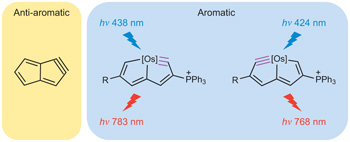Stabilization of anti-aromatic and strained five-membered rings with a transition metal

Anti-aromatic compounds, as well as small cyclic alkynes or carbynes, are particularly challenging synthetic goals. The combination of their destabilizing features hinders attempts to prepare molecules such as pentalyne, an 8π-electron anti-aromatic bicycle with extremely high ring strain. Here we describe the facile synthesis of osmapentalyne derivatives that are thermally viable, despite containing the smallest angles observed so far at a carbyne carbon. The compounds are characterized using X-ray crystallography, and their computed energies and magnetic properties reveal aromatic character. Hence, the incorporation of the osmium centre not only reduces the ring strain of the parent pentalyne, but also converts its Hückel anti-aromaticity into Craig-type Möbius aromaticity in the metallapentalynes. The concept of aromaticity is thus extended to five-membered rings containing a metal–carbon triple bond. Moreover, these metal–aromatic compounds exhibit unusual optical effects such as near-infrared photoluminescence with particularly large Stokes shifts, long lifetimes and aggregation enhancement.
